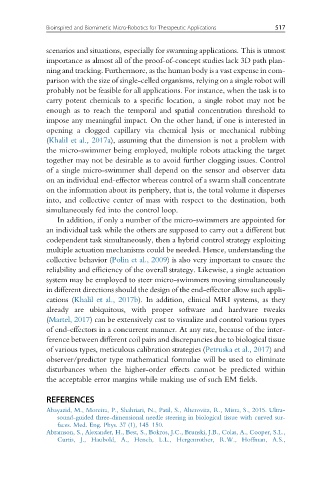Page 524 - Handbook of Biomechatronics
P. 524
Bioinspired and Biomimetic Micro-Robotics for Therapeutic Applications 517
scenarios and situations, especially for swarming applications. This is utmost
importance as almost all of the proof-of-concept studies lack 3D path plan-
ning and tracking. Furthermore, as the human body is a vast expense in com-
parison with the size of single-celled organisms, relying on a single robot will
probably not be feasible for all applications. For instance, when the task is to
carry potent chemicals to a specific location, a single robot may not be
enough as to reach the temporal and spatial concentration threshold to
impose any meaningful impact. On the other hand, if one is interested in
opening a clogged capillary via chemical lysis or mechanical rubbing
(Khalil et al., 2017a), assuming that the dimension is not a problem with
the micro-swimmer being employed, multiple robots attacking the target
together may not be desirable as to avoid further clogging issues. Control
of a single micro-swimmer shall depend on the sensor and observer data
on an individual end-effector whereas control of a swarm shall concentrate
on the information about its periphery, that is, the total volume it disperses
into, and collective center of mass with respect to the destination, both
simultaneously fed into the control loop.
In addition, if only a number of the micro-swimmers are appointed for
an individual task while the others are supposed to carry out a different but
codependent task simultaneously, then a hybrid control strategy exploiting
multiple actuation mechanisms could be needed. Hence, understanding the
collective behavior (Polin et al., 2009) is also very important to ensure the
reliability and efficiency of the overall strategy. Likewise, a single actuation
system may be employed to steer micro-swimmers moving simultaneously
in different directions should the design of the end-effector allow such appli-
cations (Khalil et al., 2017b). In addition, clinical MRI systems, as they
already are ubiquitous, with proper software and hardware tweaks
(Martel, 2017) can be extensively cast to visualize and control various types
of end-effectors in a concurrent manner. At any rate, because of the inter-
ference between different coil pairs and discrepancies due to biological tissue
of various types, meticulous calibration strategies (Petruska et al., 2017) and
observer/predictor type mathematical formulae will be used to eliminate
disturbances when the higher-order effects cannot be predicted within
the acceptable error margins while making use of such EM fields.
REFERENCES
Abayazid, M., Moreira, P., Shahriari, N., Patil, S., Alterovitz, R., Misra, S., 2015. Ultra-
sound-guided three-dimensional needle steering in biological tissue with curved sur-
faces. Med. Eng. Phys. 37 (1), 145–150.
Abramson, S., Alexander, H., Best, S., Bokros, J.C., Brunski, J.B., Colas, A., Cooper, S.L.,
Curtis, J., Haubold, A., Hench, L.L., Hergenrother, R.W., Hoffman, A.S.,

